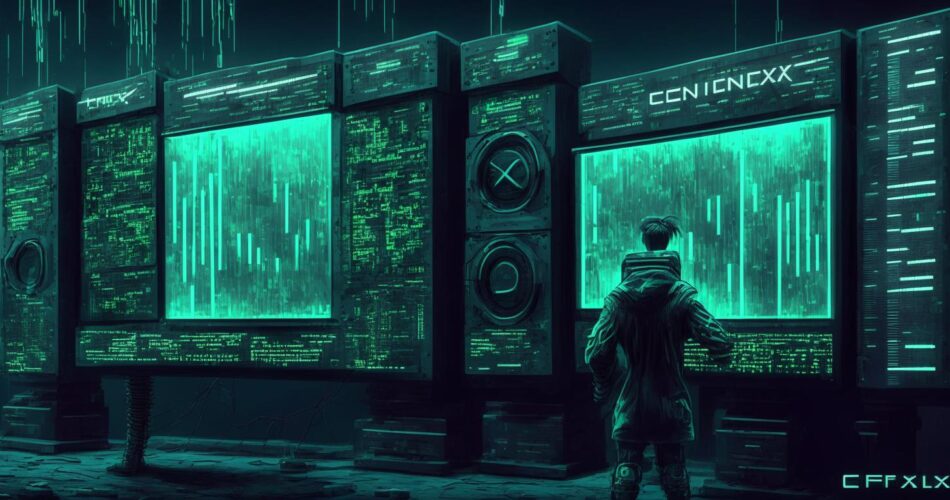In the vast universe of cryptocurrencies, Conflux (CFX) shines brightly as a unique star. If you’ve ever wondered how to mine CFX, you’re in the right place. This comprehensive guide will walk you through the process, from understanding the basics of CFX to selling your mined tokens. Let’s embark on this exciting journey!
Table of Contents
Understanding CFX
Conflux (CFX) is a high-performance blockchain network that has gained significant attention in the crypto world. Its unique Tree-Graph consensus algorithm, high security, interoperability, scalability, and built-in staking features set it apart from other cryptocurrencies. The CFX coin, the lifeblood of the Conflux Network, is used to pay transaction fees, earn staking rewards, rent storage, and participate in network governance.
CFX Dag Size
7 Gb (so it requires 8Gb GPU)
Conflux Block Reward (Current)
A New Era of Profitability in Conflux Mining
Mining Conflux (CFX) has recently transformed into an extraordinarily lucrative venture. With the potential for miners to earn up to 3000% extra income from a single block, the Conflux network is redefining the rewards of blockchain mining.
Integration with Chinese Pop Culture and NFT Marketplace
China has launched an NFT marketplace powered by the Conflux network. This development is not just a technical leap but also a cultural one. The marketplace is gaining momentum through strategic engagement with the entertainment industry. Popular rap artists, K-pop groups, and a countrywide tour are part of this innovative amalgamation of blockchain technology and show business.
The Social Media Effect: Weibo and its Influence
Weibo, a popular social media platform in China, plays a pivotal role in this ecosystem. With fanbases that can mobilize millions of users, the impact of social media in driving the popularity and adoption of Conflux-related NFTs cannot be understated. The sheer scale of this influence is uniquely characteristic of the Chinese market.
The Technological Edge: MEV and Enhanced Rewards in Mining
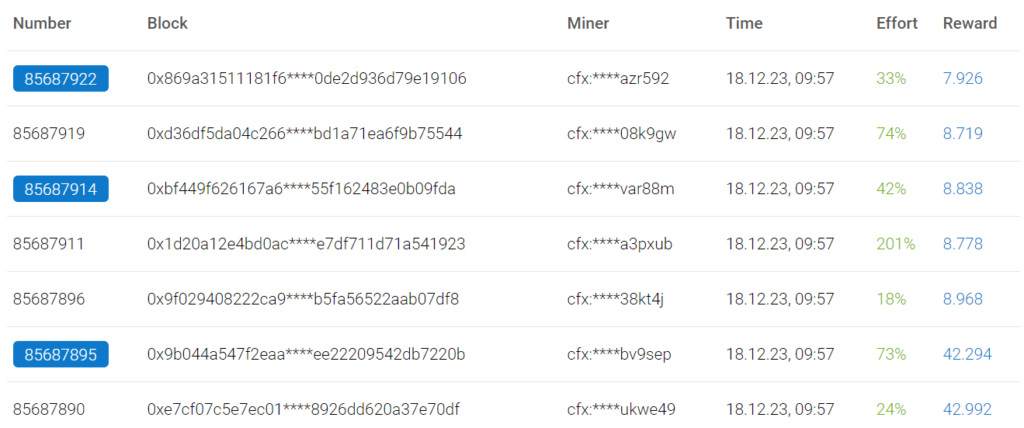
In the technical realm, Conflux mining is currently experiencing a surge in Miner Extractable Value (MEV). This phenomenon is contributing to enhanced rewards for miners. Unlike traditional mining that rewards a single coin, Conflux mining involves minting, transactions, and other network manipulations that can result in significantly higher rewards – sometimes as much as 40 to over 3000 coins per block.
The Bottom Line for Miners
The extraordinary aspect of this development is the direct financial benefit to pools and individual miners who successfully mine these blocks. This additional income from mining activities represents a new frontier in blockchain mining, making Conflux an attractive option for miners looking for high-reward opportunities.
Preparation for Mining
Before you start mining CFX, you need to prepare the right hardware and software. According to WoolyPooly, one of the leading mining pools for CFX, Nvidia RTX 20/30/40 (8GB required) series are particularly efficient for this task.
Conflux Mining Calculators
Essential Tools for Every Conflux Miner
To maximize the profitability of Conflux (CFX) mining, it’s crucial for miners to use mining calculators. These tools provide vital insights into potential earnings and help in making informed decisions. Here are some of the most reliable Conflux mining calculators available:
1. Woolypooly
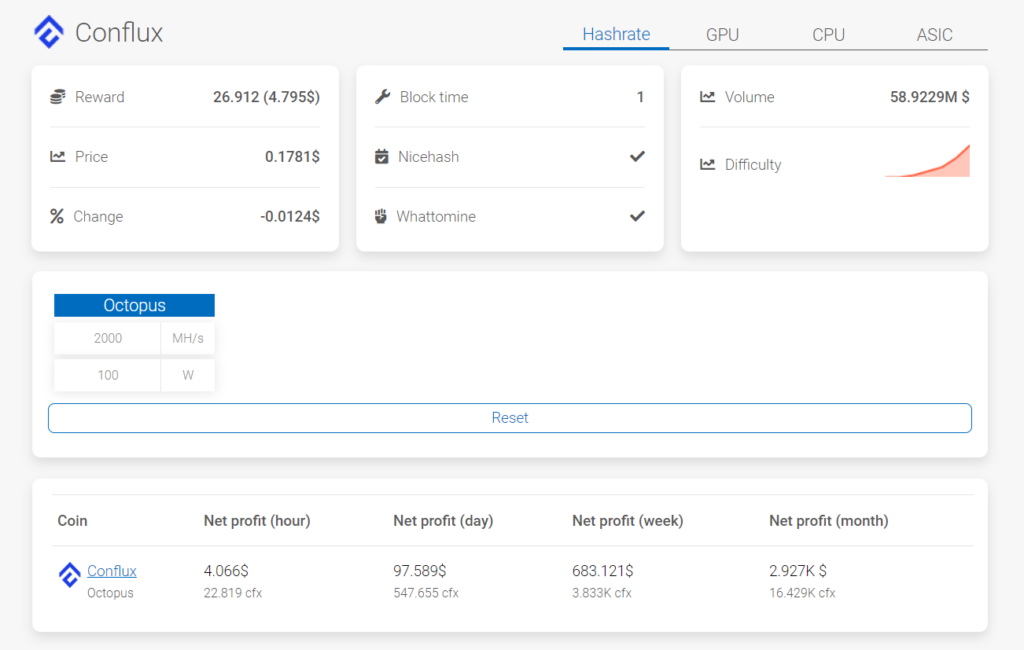
Woolypooly’s CFX Calculator is a user-friendly tool designed for both novice and experienced miners. It allows users to input their mining hardware details, including hash rate and power consumption, to estimate potential earnings from CFX mining. This calculator also considers the current difficulty and block reward, providing an up-to-date profitability analysis.
2. WhatToMine
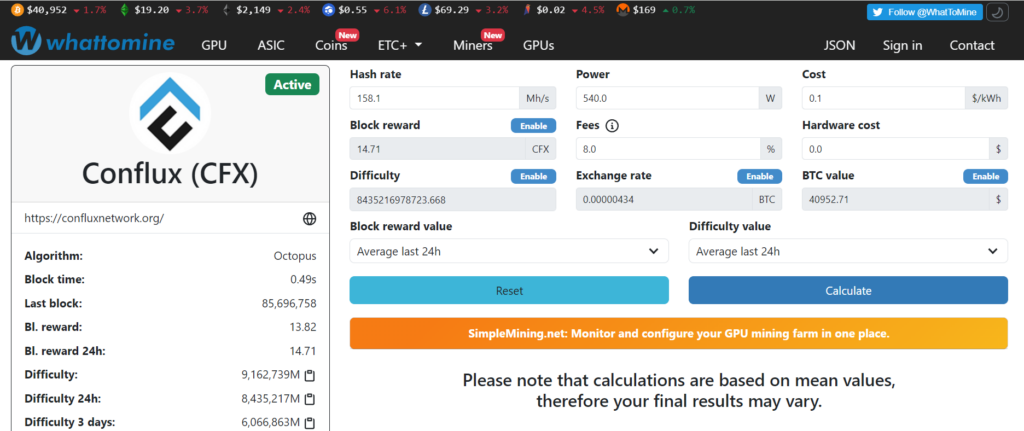
WhatToMine‘s CFX Calculator is another excellent resource for miners. Known for its comprehensive approach, this calculator factors in various parameters such as electricity costs, mining pool fees, and hardware efficiency. It’s particularly helpful for miners who want a detailed breakdown of their potential income and expenses.
3. Minerstat
Minerstat offers a Conflux mining calculator that stands out for its simplicity and accuracy. It provides an easy-to-use interface where miners can quickly input their mining setup details and get an estimate of their earnings. Minerstat’s calculator also updates regularly to reflect the latest network conditions and market prices, ensuring that miners have the most current data for their calculations.
Choosing a Mining Pool
Conflux Pools

Mining pools are essential for individual miners as they combine the computational resources of several miners to increase the chances of finding a block. This collective effort results in more frequent, albeit smaller, rewards for each miner. When choosing a mining pool for mining CFX, several factors come into play.
One of the most important factors is the payout scheme the pool uses. The payout scheme determines how the rewards from mining a block are distributed among the miners in the pool. There are several payout schemes used by different mining pools, but the most common ones are Pay Per Last N Shares (PPLNS) and Pay Per Share (PPS).
PPLNS is a popular choice among miners because it rewards loyal pool members more than pool hoppers (miners who frequently switch between pools). In PPLNS, the rewards are distributed based on the number of valid shares each miner contributed during the last N rounds, where N is a number that varies from pool to pool. This method encourages miners to stay with the pool for longer periods, which ultimately benefits the stability and hashing power of the pool.
WoolyPooly, a leading mining pool for CFX, offers both PPLNS and SOLO mining methods. However, PPLNS is often the best option for most miners due to its fairness and potential for higher long-term rewards.
Other factors to consider when choosing a mining pool include the pool’s total hashing power, the pool’s fee structure, the reliability and security of the pool, and the quality of the pool’s user interface and customer support. It’s important to do your research and choose a mining pool that aligns with your mining goals and preferences.
How to Mine CFX on WoolyPooly
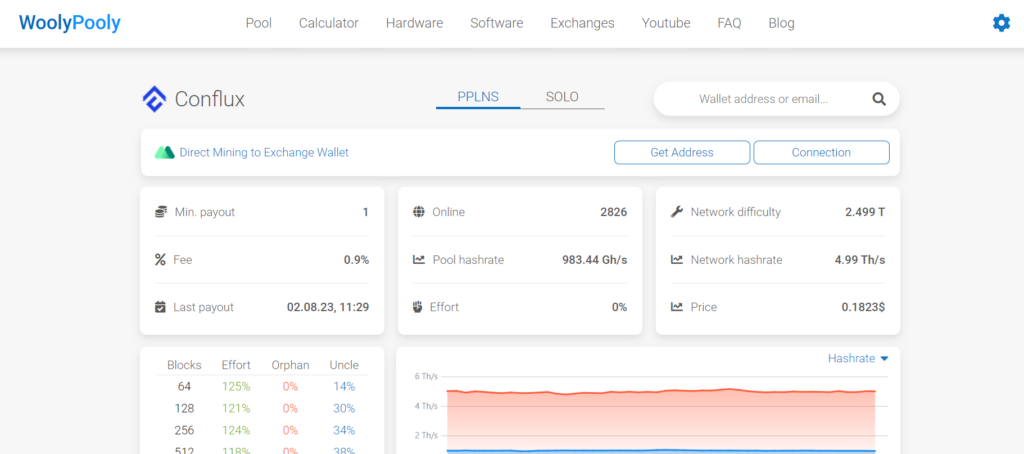
Mining CFX on WoolyPooly is a straightforward process that involves a few key steps. Before you begin, ensure that you have the necessary hardware and software, as discussed earlier. Once you’re ready, follow these steps:
Step 1: Set Up the Wallet

Before you start mining, you need to set up a CFX wallet. This wallet will be used to receive the Conflux that you mine. You can choose to use any wallet that supports CFX, but make sure that it’s secure and that you have control over the private keys. You can even mine directly to an exchange that supports CFX, like MEXC, and sell your coins there. However, remember that mining directly to an exchange may have additional risks and it’s important to ensure the exchange supports mining payouts.
Step 2: Choose Your Preferred Mining Method
WoolyPooly offers both Pay Per Last N Shares (PPLNS) and SOLO mining methods. As mentioned earlier, PPLNS is often the best option for most miners due to its fairness and potential for higher long-term rewards.
Step 3: Set Up Your Conflux Miner
This is where you’ll need to configure your mining software to work with WoolyPooly and start mining CFX. WoolyPooly supports several mining software, including T-Rex, Gminer, Rigel, and Nbminer, which are highly recommended for mining CFX.
Here are the batch (bat) files you’ll need to use for each:
For T-Rex:
t-rex -a octopus -o stratum+tcp://pool.woolypooly.com:3094 -u WALLET_ADDRESS.WORKER_NAME -p xFor Gminer:
miner.exe --algo octopus --server pool.woolypooly.com:3094 --user WALLET_ADDRESS.WORKER_NAMEConflux + Ironfish + Zil
miner.exe --algo octopus --server pool.woolypooly.com:3094 --user WALLET_ADDRESS_CFX.WORKER_NAME --dalgo ironfish --dserver IRONFISH_POOL --duser WALLET_ADDRESS_IRON.WORKER_NAME --zilserver ZIL_POOL --ziluser WALLET_ADDRESS_ZIL.WORKER_NAMEFor Nbminer:
nbminer.exe -a octopus -o stratum+tcp://pool.woolypooly.com:3094 -u WALLET_ADDRESS.WORKER_NAMEFor Rigel:
rigel.exe -a octopus -o stratum+tcp://pool.woolypooly.com:3094 -u WALLET_ADDRESS.WORKER_NAME --log-file logs/miner.logConflux + Alephium Dual Mining
rigel.exe -a octopus+alephium ^
-o [1]stratum+tcp://pool.woolypooly.com:3094 -u [1]WALLET_ADDRESS_CFX.WORKER_NAME ^
-o [2]stratum+tcp://pool.woolypooly.com:3106 -u [2]WALLET_ADDRESS_ALPH.WORKER_NAME ^
--log-file logs/miner.logConflux + Radiant Dual Mining
rigel.exe -a octopus+sha512256d ^
-o [1]stratum+tcp://pool.woolypooly.com:3094 -u [1]WALLET_ADDRESS_CFX.WORKER_NAME ^
-o [2]stratum+tcp://pool.woolypooly.com:3122 -u [2]WALLET_ADDRESS_RXD.WORKER_NAME ^
--log-file logs/miner.logIn these commands, replace WALLET_ADDRESS with your CFX wallet address and WORKER_NAME with a name for your mining machine. This name will help you identify the machine on WoolyPooly’s dashboard.
Step 4: Start Mining
Once your mining software is set up, you can start mining. Your mining software will begin to solve complex mathematical problems, and when it finds a solution, it will submit it to the WoolyPooly. If the solution is correct, the pool will add a new block to the blockchain and distribute the block reward among the miners according to the PPLNS scheme.
Remember to monitor your mining progress and make any necessary adjustments to ensure optimal performance. Happy mining!
Understanding Mining Results
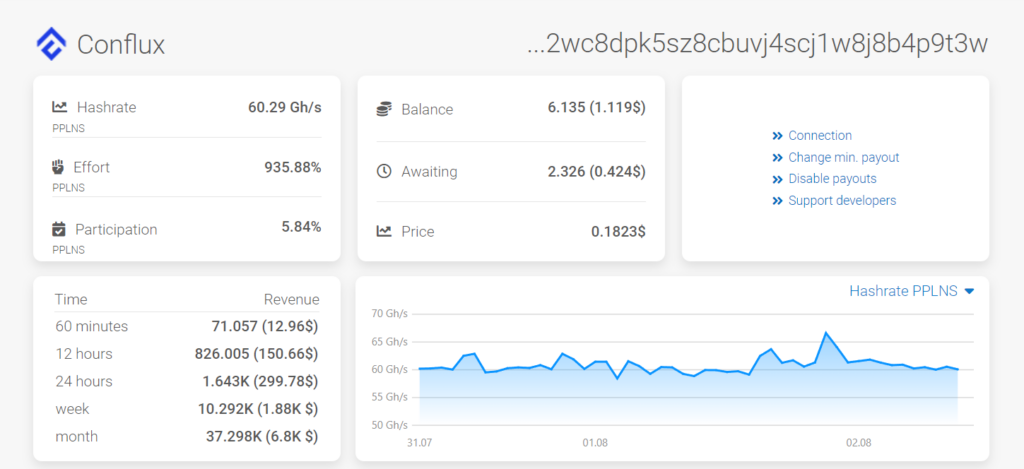
Once you’ve started mining CFX on WoolyPooly, it’s important to understand the results you’re seeing. This will help you gauge your mining performance and make necessary adjustments to optimize your efforts. Here are some key terms and metrics you’ll encounter:
- Block Effort: This refers to the amount of work done by the pool to find a block, expressed as a percentage. A block effort of 100% means the pool needed to do the expected amount of work to find a block. If the block effort is less than 100%, the pool was lucky and found the block sooner than expected. If it’s more than 100%, the pool was unlucky and had to do more work to find the block.
- Rewards: These are the CFX coins you earn for your contribution to the pool’s mining effort. The amount of rewards you receive depends on the number of valid shares you submitted, the block reward, and the pool’s payout scheme. In a PPLNS scheme, loyal miners who stay with the pool longer can earn more rewards.
- Hashrate: This is a measure of your mining machine’s performance. It indicates how many hashes (solutions to the mathematical problems) your machine can calculate per second. A higher hashrate means your machine can solve more problems and potentially earn more rewards.
- Payout: This is the amount of CFX you’ve earned that’s been paid out to your wallet. On WoolyPooly, payouts are made automatically once you reach the minimum payout threshold.
- Online Miners: This shows the number of miners currently active in the pool. A higher number of miners means more competition, but it also means the pool has a higher chance of finding blocks.
- Pool Hashrate: This is the total combined hashrate of all miners in the pool. A higher pool hashrate increases the pool’s chances of finding blocks.
By understanding these metrics, you can better assess your mining performance and profitability. Remember, mining is a long-term endeavor, and daily fluctuations in these metrics are normal. The key is to stay consistent and make adjustments as needed to ensure your mining operation remains profitable.
Selling Mined CFX
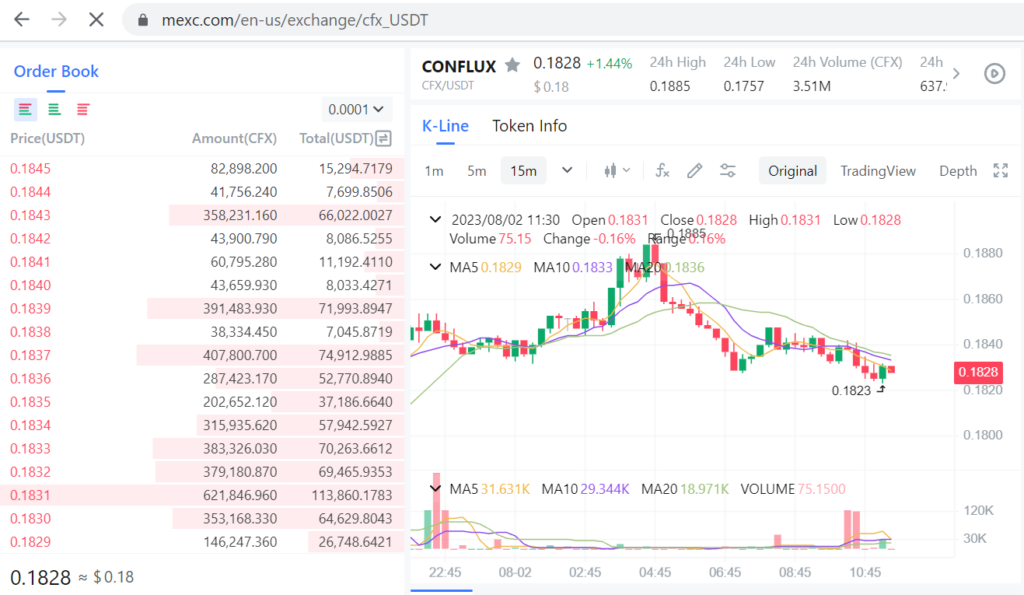
Once you’ve mined CFX, you can sell it on various exchanges. MEXC is a popular cryptocurrency exchange that supports a wide range of cryptocurrencies, including CFX.
After your CFX deposit has been confirmed, you can trade your CFX for USDT. Navigate to the “Exchange” section of MEXC and select the CFX/USDT trading pair. Here, you can set your sell order. You can choose to sell your CFX at the current market price (a “market” order) or set your own price (a “limit” order).
Confirm Your Trade
Once you’ve set your sell order, review the details to make sure everything is correct. When you’re ready, confirm your trade. Your CFX will be sold for USDT according to the terms of your order.
Withdraw Your USDT
After your trade has been completed, your USDT will be available in your MEXC wallet. You can choose to keep your USDT on MEXC for future trades, or you can withdraw it to another wallet.
Conclusion
The journey of mining CFX is an exciting venture that offers both financial rewards and a deeper understanding of blockchain technology. By choosing the right hardware and software, joining a reliable mining pool like WoolyPooly, and diligently monitoring your mining results, you can effectively mine CFX and contribute to the Conflux Network.
Selling your mined CFX is a crucial part of the process, and platforms like MEXC make this step straightforward and secure. However, always remember to exercise caution and do your own research when engaging in cryptocurrency transactions.
Mining CFX is more than just a potential source of income. It’s a way to participate in the growth of a promising blockchain network and contribute to the broader cryptocurrency ecosystem. As you embark on your mining journey, remember that patience, consistency, and a willingness to learn are your best allies.
Whether you’re a seasoned miner or a newcomer to the crypto world, mining CFX offers a unique opportunity to deepen your understanding of cryptocurrencies and blockchain technology. So, gear up, stay informed, and happy mining!
FAQs
What hardware and software do I need to mine CFX?
For hardware, Nvidia GTX 16 and RTX 20/30 series are recommended for mining CFX. For software, T-Rex and Nbminer are commonly used. You’ll also need a CFX wallet to receive your mined tokens.
How do I choose a mining pool?
When choosing a mining pool, consider factors like the pool’s total hashing power, the pool’s fee structure, the reliability and security of the pool, and the quality of the pool’s user interface and customer support. WoolyPooly is a popular choice for CFX miners due to its low fees, minimum payout, and high pool hashrate.
How do I mine CFX on WoolyPooly?
To mine CFX on WoolyPooly, you first need to set up a CFX wallet. Then, choose your preferred mining method on WoolyPooly (PPLNS is recommended). Set up your mining software using the provided batch files, replacing WALLET_ADDRESS with your CFX wallet address and WORKER_NAME with a name for your mining machine. Once everything is set up, you can start mining.
How do I understand my mining results?
Understanding your mining results involves understanding key metrics like block effort, rewards, hashrate, payout, online miners, and pool hashrate. These metrics help you gauge your mining performance and make necessary adjustments to optimize your efforts.
Where can I sell my mined CFX?
You can sell your mined CFX on any exchange that supports it. Mexc.com is a recommended platform due to its user-friendly interface and no KYC requirement. However, avoid mining directly to an exchange unless it supports mining payouts.
